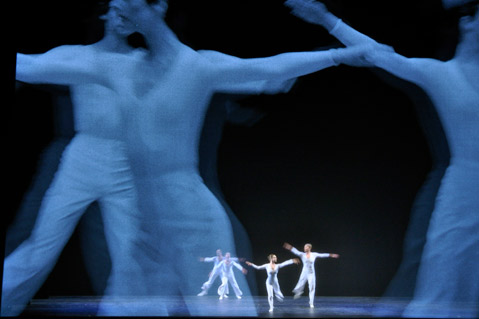Lucinda Childs’s Dance Comes to Santa Barbara
Groundbreaking Minimalist Work Features Philip Glass Score

Entertaining/conceptual, narrative/abstract, technical/pedestrian, held/released—it’s common for today’s dance companies to embody contradictory styles and forms. In fact, in the 21st century, such versatility has become essential to a company’s survival. But it wasn’t always this way. As recently as the 1970s, the landscape of American dance was dramatically polarized. It wasn’t unusual for Manhattan studios located within blocks of one another to have no dialogue or shared clientele whatsoever. Dancers showed their loyalty by choosing one camp and eschewing all others. Like oppositional teenagers, artists and creative movements claimed their turf as much by negative self-definition as by experimentation.
It was out of this charged breeding ground that dance artist Lucinda Childs emerged.
This Tuesday, May 10, Childs brings her seminal work from 1979, Dance, to The Granada. It’s a work that sent audience members streaming out of theaters when it was first performed. Set to the glittering cascade of Philip Glass’s score and performed live in front of Sol LeWitt’s black-and-white film, it’s a minimalist masterpiece, and a study in pattern, synchrony, and precision.
Speaking on the phone from her hotel room while on tour last month, Childs explained the atmosphere surrounding her in the period leading up to the creation of Dance. “It felt like we were reaching a dead end—like everything had been done,” she said, citing pop art as well as her involvement with the experimental Judson Dance Theater of the 1960s. She found new inspiration in the minimalist movement, particularly in visual art. “The minimalist movement suggested there were new things to think about—that we could go back to very simple movement ideas.” In dance, the king of minimalism was, of course, Merce Cunningham, whose rejection of narrative structure was unprecedented and groundbreaking.
“The exciting thing about Cunningham for me was the underlying statement that dance in and of itself is an art form,” explained Childs, who studied with Cunningham at Sarah Lawrence College in the early 1960s. “I found his movement experiments and his collaborations with John Cage very exciting. They opened my eyes to a new way of working.”
And yet Cunningham’s infatuation with the coincidental—his habit of rolling the dice to choose an order for his choreography, or of sending dancers on stage to perform to music they’d never heard before—didn’t suit Childs. Instead, she explained, as she began to pursue her own career, she developed a method of creating dances with no music at all, and then collaborating with a composer in a more traditional approach.
Such was the case with Dance, a three-way collaboration between Childs, Glass, and LeWitt. Childs first collaborated with Glass in 1976 on the opera Einstein on the Beach, a revival of which is scheduled to premiere next year. Up until that time, Childs hadn’t worked with a composer. In developing her solo for the opera, she explained, “I was very concerned about how to put the choreography and the music together—how to create a structure that would work, so that I wasn’t just improvising to the music. In order to do that you need to know about the structure.”
Structure was to become key for Childs, and it forms the subject of Dance. Though the steps consist of relatively simple ballet movements, it’s a demanding piece to perform, both athletically and in terms of the technical precision required of the dancers. Intense focus is needed to maintain symmetry and timing, and the intricate geometric patterns, like Glass’s music, are at once starkly linear and lush in their complexity.
Though Dance was well received in some quarters, it garnered angry responses in others. Reflecting on why that might have been the case, Childs noted, “I think it might have had to do with the fact that the vocabulary is really quite simple. Some people looked at it and said, ‘Oh, that’s easy; anyone can do it.’ Some said, ‘That’s not really dance—those steps don’t require skill.’ But that’s not true at all.”
In 1979, Childs’s company consisted of a diverse group of performers with varied backgrounds. In revivals of the work since that time, she has chosen more homogenous companies of dancers. Because LeWitt’s film footage features the original company and is perfectly synchronized with the live performers, it’s possible to compare the old version with the new performance style. As professional dancers become increasingly versatile, the individual performance qualities evident in the original are exchanged for a crisper, more uniform ensemble. Because of the juxtaposition of archival film with live performance, Dance offers a unique chance to reflect on this shift.
Regardless of the conclusions Santa Barbara audience members draw from the comparison, or from the work as a whole, it’s unlikely they’ll storm out of the theater. These days, Childs noted, the public tends to be far more open-minded than they were in the 1970s, a shift she sees as positive. “People in this day and age tend to get involved in the whole experience of it,” she said, adding that no particular education or background should be required in order to enjoy Dance. “It’s a completely open experience. Just accept it for what it is, and enjoy it.”
4•1•1
Arts & Lectures presents Lucinda Childs’s Dance at The Granada on Tuesday, May 10, at 8 p.m. For tickets, call 893-3535 or visit artsandlectures.sa.ucsb.edu.



